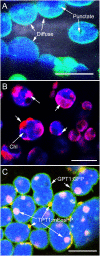Plastid Envelope-Localized Proteins Exhibit a Stochastic Spatiotemporal Relationship to Stromules
- PMID: 29915611
- PMCID: PMC5995270
- DOI: 10.3389/fpls.2018.00754
Plastid Envelope-Localized Proteins Exhibit a Stochastic Spatiotemporal Relationship to Stromules
Abstract
Plastids in the viridiplantae sporadically form thin tubules called stromules that increase the interactive surface between the plastid and the surrounding cytoplasm. Several recent publications that report observations of certain proteins localizing to the extensions have then used the observations to suggest stromule-specific functions. The mechanisms by which specific localizations on these transient and sporadically formed extensions might occur remain unclear. Previous studies have yet to address the spatiotemporal relationship between a particular protein localization pattern and its distribution on an extended stromules and/or the plastid body. Here, we have used discrete protein patches found in several transgenic plants as fiducial markers to investigate this relationship. While we consider the inner plastid envelope-membrane localized protein patches of the GLUCOSE 6-PHOSPHATE/PHOSPHATE TRANSLOCATOR1 and the TRIOSE-PHOSPHATE/ PHOSPHATE TRANSLOCATOR 1 as artifacts of fluorescent fusion protein over-expression, stromule formation is not compromised in the respective stable transgenic lines that maintain normal growth and development. Our analysis of chloroplasts in the transgenic lines in the Arabidopsis Columbia background, and in the arc6 mutant, under stromule-inducing conditions shows that the possibility of finding a particular protein-enriched domain on an extended stromule or on a region of the main plastid body is stochastic. Our observations provide insights on the behavior of chloroplasts, the relationship between stromules and the plastid-body and strongly challenge claims of stromule-specific functions based solely upon protein localization to plastid extensions.
One sentence summary: Observations of the spatiotemporal relationship between plastid envelope localized fluorescent protein fusions of two sugar-phosphate transporters and stromules suggest a stochastic rather than specific localization pattern that questions the idea of independent functions for stromules.
Keywords: chloroplast proteins; fluorescent proteins; plastids; stromules; transporters.
Figures




Similar articles
-
Effects of arc3, arc5 and arc6 mutations on plastid morphology and stromule formation in green and nongreen tissues of Arabidopsis thaliana.Photochem Photobiol. 2008 Nov-Dec;84(6):1324-35. doi: 10.1111/j.1751-1097.2008.00437.x. Epub 2008 Aug 29. Photochem Photobiol. 2008. PMID: 18764889
-
Stromule formation is dependent upon plastid size, plastid differentiation status and the density of plastids within the cell.Plant J. 2004 Aug;39(4):655-67. doi: 10.1111/j.1365-313X.2004.02164.x. Plant J. 2004. PMID: 15272881
-
Plastid-Nucleus Distance Alters the Behavior of Stromules.Front Plant Sci. 2017 Jul 6;8:1135. doi: 10.3389/fpls.2017.01135. eCollection 2017. Front Plant Sci. 2017. PMID: 28729870 Free PMC article.
-
Stromules and the dynamic nature of plastid morphology.J Microsc. 2004 May;214(Pt 2):124-37. doi: 10.1111/j.0022-2720.2004.01317.x. J Microsc. 2004. PMID: 15102061 Review.
-
Stromules: a characteristic cell-specific feature of plastid morphology.J Exp Bot. 2005 Mar;56(413):787-97. doi: 10.1093/jxb/eri088. Epub 2005 Feb 7. J Exp Bot. 2005. PMID: 15699062 Review.
Cited by
-
Chloroplast Auxin Efflux Mediated by ABCB28 and ABCB29 Fine-Tunes Salt and Drought Stress Responses in Arabidopsis.Plants (Basel). 2023 Dec 19;13(1):7. doi: 10.3390/plants13010007. Plants (Basel). 2023. PMID: 38202315 Free PMC article.
-
Accumulation of dually targeted StGPT1 in chloroplasts mediated by StRFP1, an E3 ubiquitin ligase, enhances plant immunity.Hortic Res. 2024 Aug 30;11(11):uhae241. doi: 10.1093/hr/uhae241. eCollection 2024 Nov. Hortic Res. 2024. PMID: 39512780 Free PMC article.
-
Organelle extensions in plant cells.Plant Physiol. 2021 Apr 2;185(3):593-607. doi: 10.1093/plphys/kiaa055. Plant Physiol. 2021. PMID: 33793902 Free PMC article.
-
Using ER-Targeted Photoconvertible Fluorescent Proteins in Living Plant Cells.Methods Mol Biol. 2024;2772:291-299. doi: 10.1007/978-1-0716-3710-4_22. Methods Mol Biol. 2024. PMID: 38411823
-
Membrane contacts with the endoplasmic reticulum modulate plastid morphology and behaviour.Front Plant Sci. 2023 Dec 4;14:1293906. doi: 10.3389/fpls.2023.1293906. eCollection 2023. Front Plant Sci. 2023. PMID: 38111880 Free PMC article.
References
LinkOut - more resources
Full Text Sources
Other Literature Sources
Molecular Biology Databases

